HLT301 Semester 1: Mental State Examination Workbook Assignment
VerifiedAdded on 2022/08/08
|9
|2208
|21
Homework Assignment
AI Summary
This Mental State Examination Workbook presents a comprehensive analysis of a case study involving a patient, Andy, exhibiting symptoms of psychosis. The assignment begins with defining the Mental State Assessment and its significance in nursing and midwifery practices, followed by a detailed description of Andy's appearance, behavior, speech, mood, and affect during the initial assessment. It differentiates between mood and affect, and explores the signs and symptoms of psychosis observed in Andy. The workbook then delves into potential tests Dr. Taylor might request, and how she would document her findings. It assesses Andy's insight into his condition, potential risks, and appropriate interventions and care pathways, including medication, therapies like Self-Control Therapy, vocational rehabilitation, Cognitive Behavioral Therapy, Arts Therapy and holistic approaches, considering both in-patient and out-patient settings. References are provided to support the findings.
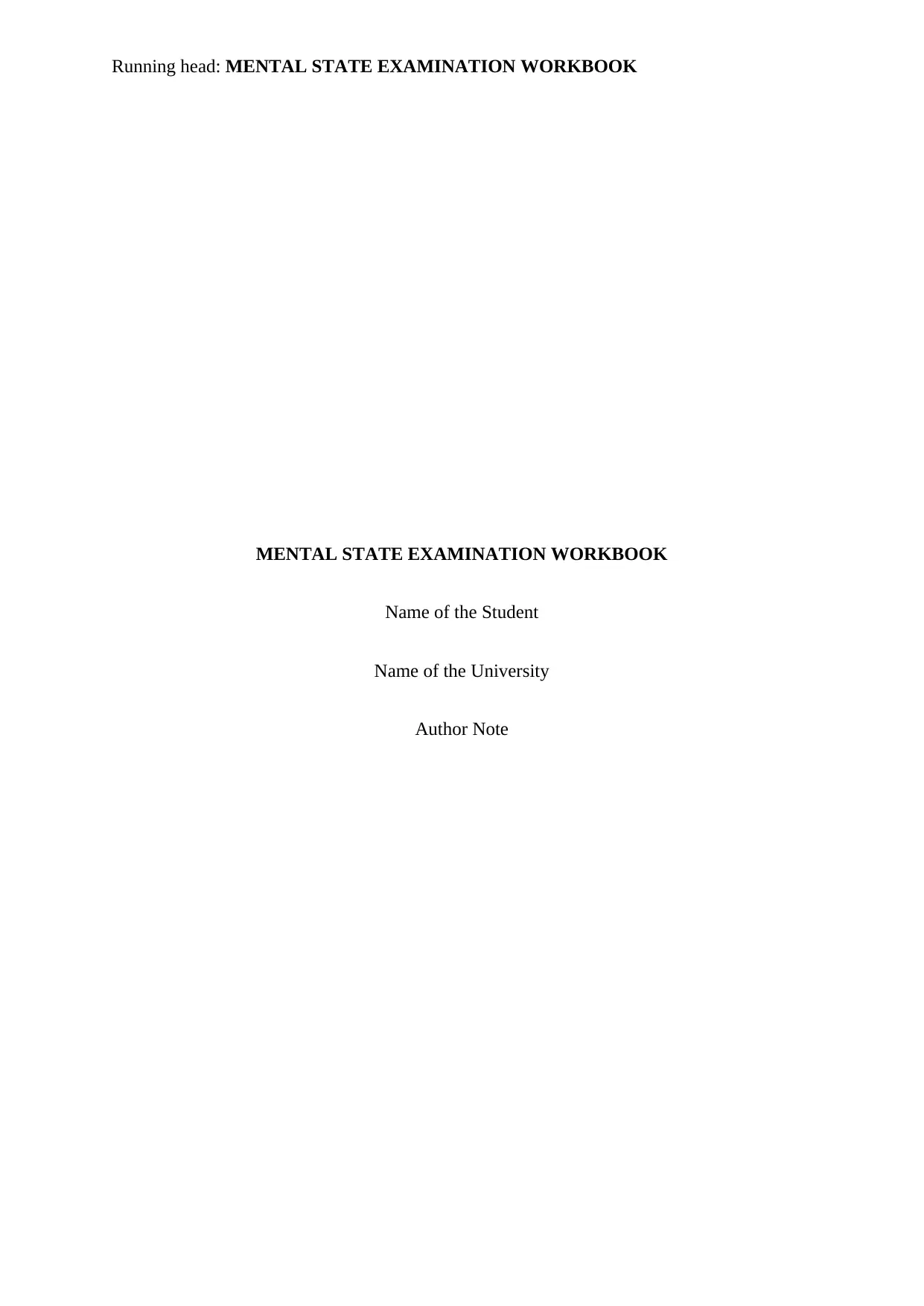
Running head: MENTAL STATE EXAMINATION WORKBOOK
MENTAL STATE EXAMINATION WORKBOOK
Name of the Student
Name of the University
Author Note
MENTAL STATE EXAMINATION WORKBOOK
Name of the Student
Name of the University
Author Note
Paraphrase This Document
Need a fresh take? Get an instant paraphrase of this document with our AI Paraphraser
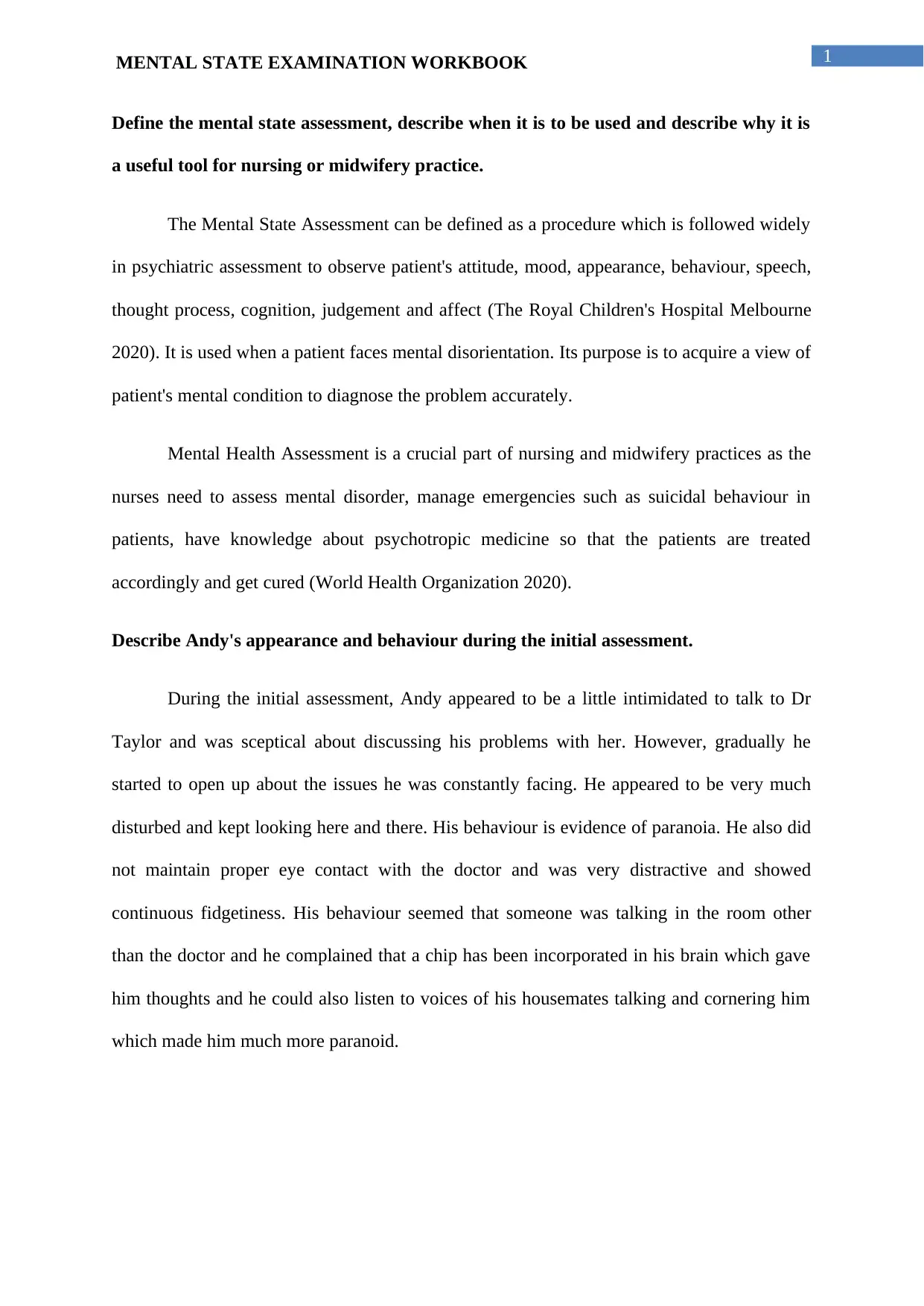
1MENTAL STATE EXAMINATION WORKBOOK
Define the mental state assessment, describe when it is to be used and describe why it is
a useful tool for nursing or midwifery practice.
The Mental State Assessment can be defined as a procedure which is followed widely
in psychiatric assessment to observe patient's attitude, mood, appearance, behaviour, speech,
thought process, cognition, judgement and affect (The Royal Children's Hospital Melbourne
2020). It is used when a patient faces mental disorientation. Its purpose is to acquire a view of
patient's mental condition to diagnose the problem accurately.
Mental Health Assessment is a crucial part of nursing and midwifery practices as the
nurses need to assess mental disorder, manage emergencies such as suicidal behaviour in
patients, have knowledge about psychotropic medicine so that the patients are treated
accordingly and get cured (World Health Organization 2020).
Describe Andy's appearance and behaviour during the initial assessment.
During the initial assessment, Andy appeared to be a little intimidated to talk to Dr
Taylor and was sceptical about discussing his problems with her. However, gradually he
started to open up about the issues he was constantly facing. He appeared to be very much
disturbed and kept looking here and there. His behaviour is evidence of paranoia. He also did
not maintain proper eye contact with the doctor and was very distractive and showed
continuous fidgetiness. His behaviour seemed that someone was talking in the room other
than the doctor and he complained that a chip has been incorporated in his brain which gave
him thoughts and he could also listen to voices of his housemates talking and cornering him
which made him much more paranoid.
Define the mental state assessment, describe when it is to be used and describe why it is
a useful tool for nursing or midwifery practice.
The Mental State Assessment can be defined as a procedure which is followed widely
in psychiatric assessment to observe patient's attitude, mood, appearance, behaviour, speech,
thought process, cognition, judgement and affect (The Royal Children's Hospital Melbourne
2020). It is used when a patient faces mental disorientation. Its purpose is to acquire a view of
patient's mental condition to diagnose the problem accurately.
Mental Health Assessment is a crucial part of nursing and midwifery practices as the
nurses need to assess mental disorder, manage emergencies such as suicidal behaviour in
patients, have knowledge about psychotropic medicine so that the patients are treated
accordingly and get cured (World Health Organization 2020).
Describe Andy's appearance and behaviour during the initial assessment.
During the initial assessment, Andy appeared to be a little intimidated to talk to Dr
Taylor and was sceptical about discussing his problems with her. However, gradually he
started to open up about the issues he was constantly facing. He appeared to be very much
disturbed and kept looking here and there. His behaviour is evidence of paranoia. He also did
not maintain proper eye contact with the doctor and was very distractive and showed
continuous fidgetiness. His behaviour seemed that someone was talking in the room other
than the doctor and he complained that a chip has been incorporated in his brain which gave
him thoughts and he could also listen to voices of his housemates talking and cornering him
which made him much more paranoid.
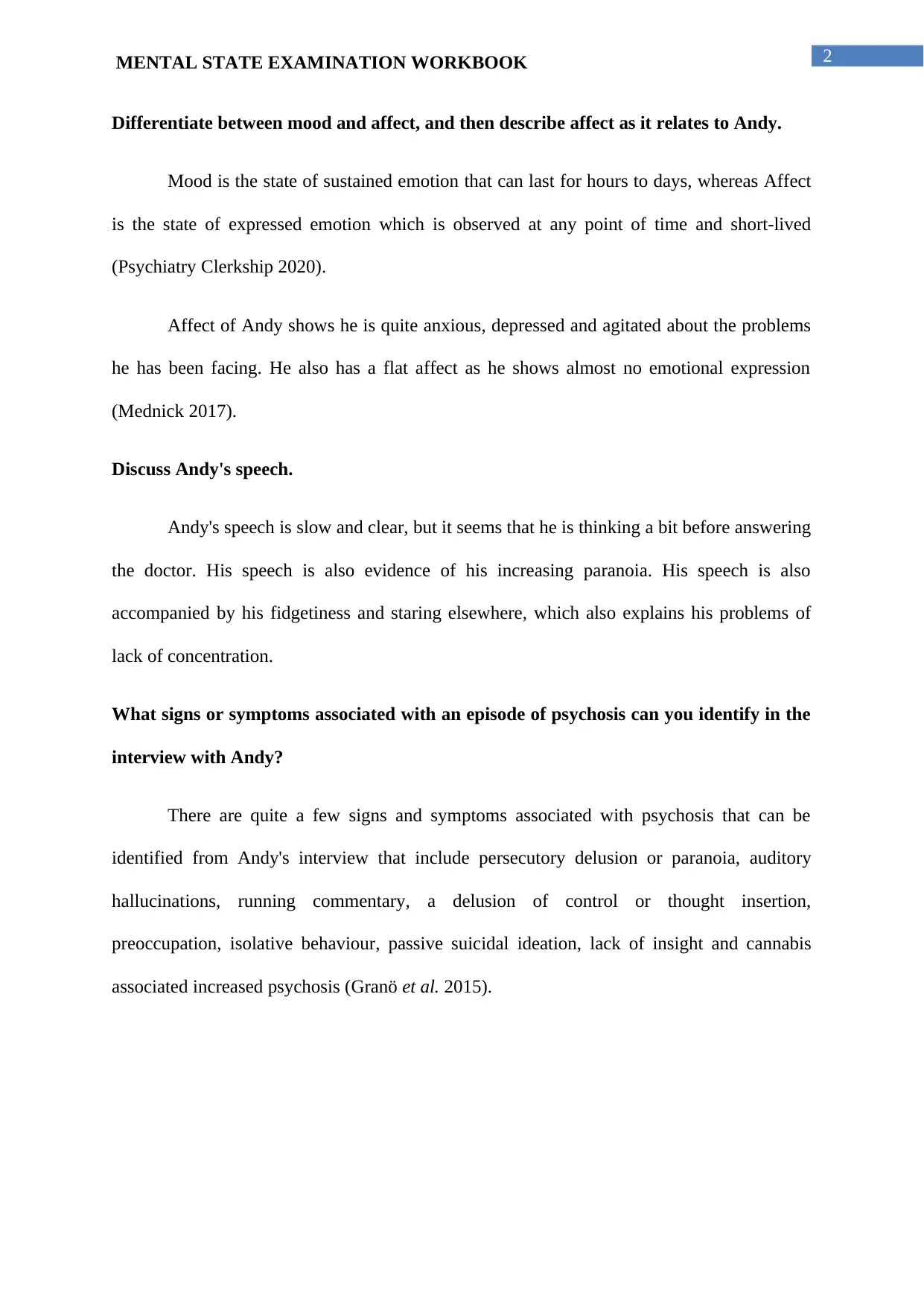
2MENTAL STATE EXAMINATION WORKBOOK
Differentiate between mood and affect, and then describe affect as it relates to Andy.
Mood is the state of sustained emotion that can last for hours to days, whereas Affect
is the state of expressed emotion which is observed at any point of time and short-lived
(Psychiatry Clerkship 2020).
Affect of Andy shows he is quite anxious, depressed and agitated about the problems
he has been facing. He also has a flat affect as he shows almost no emotional expression
(Mednick 2017).
Discuss Andy's speech.
Andy's speech is slow and clear, but it seems that he is thinking a bit before answering
the doctor. His speech is also evidence of his increasing paranoia. His speech is also
accompanied by his fidgetiness and staring elsewhere, which also explains his problems of
lack of concentration.
What signs or symptoms associated with an episode of psychosis can you identify in the
interview with Andy?
There are quite a few signs and symptoms associated with psychosis that can be
identified from Andy's interview that include persecutory delusion or paranoia, auditory
hallucinations, running commentary, a delusion of control or thought insertion,
preoccupation, isolative behaviour, passive suicidal ideation, lack of insight and cannabis
associated increased psychosis (Granö et al. 2015).
Differentiate between mood and affect, and then describe affect as it relates to Andy.
Mood is the state of sustained emotion that can last for hours to days, whereas Affect
is the state of expressed emotion which is observed at any point of time and short-lived
(Psychiatry Clerkship 2020).
Affect of Andy shows he is quite anxious, depressed and agitated about the problems
he has been facing. He also has a flat affect as he shows almost no emotional expression
(Mednick 2017).
Discuss Andy's speech.
Andy's speech is slow and clear, but it seems that he is thinking a bit before answering
the doctor. His speech is also evidence of his increasing paranoia. His speech is also
accompanied by his fidgetiness and staring elsewhere, which also explains his problems of
lack of concentration.
What signs or symptoms associated with an episode of psychosis can you identify in the
interview with Andy?
There are quite a few signs and symptoms associated with psychosis that can be
identified from Andy's interview that include persecutory delusion or paranoia, auditory
hallucinations, running commentary, a delusion of control or thought insertion,
preoccupation, isolative behaviour, passive suicidal ideation, lack of insight and cannabis
associated increased psychosis (Granö et al. 2015).
⊘ This is a preview!⊘
Do you want full access?
Subscribe today to unlock all pages.

Trusted by 1+ million students worldwide
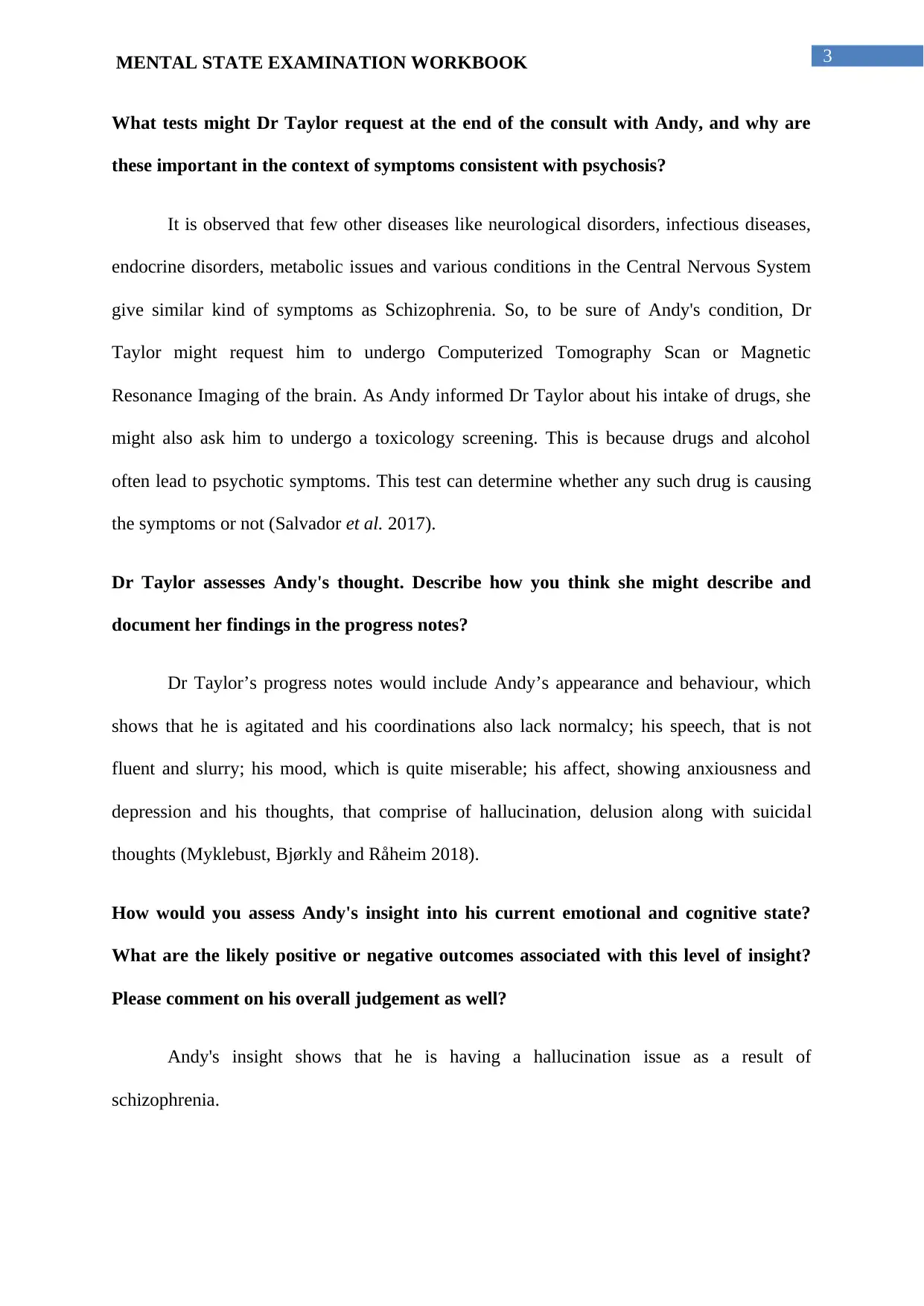
3MENTAL STATE EXAMINATION WORKBOOK
What tests might Dr Taylor request at the end of the consult with Andy, and why are
these important in the context of symptoms consistent with psychosis?
It is observed that few other diseases like neurological disorders, infectious diseases,
endocrine disorders, metabolic issues and various conditions in the Central Nervous System
give similar kind of symptoms as Schizophrenia. So, to be sure of Andy's condition, Dr
Taylor might request him to undergo Computerized Tomography Scan or Magnetic
Resonance Imaging of the brain. As Andy informed Dr Taylor about his intake of drugs, she
might also ask him to undergo a toxicology screening. This is because drugs and alcohol
often lead to psychotic symptoms. This test can determine whether any such drug is causing
the symptoms or not (Salvador et al. 2017).
Dr Taylor assesses Andy's thought. Describe how you think she might describe and
document her findings in the progress notes?
Dr Taylor’s progress notes would include Andy’s appearance and behaviour, which
shows that he is agitated and his coordinations also lack normalcy; his speech, that is not
fluent and slurry; his mood, which is quite miserable; his affect, showing anxiousness and
depression and his thoughts, that comprise of hallucination, delusion along with suicidal
thoughts (Myklebust, Bjørkly and Råheim 2018).
How would you assess Andy's insight into his current emotional and cognitive state?
What are the likely positive or negative outcomes associated with this level of insight?
Please comment on his overall judgement as well?
Andy's insight shows that he is having a hallucination issue as a result of
schizophrenia.
What tests might Dr Taylor request at the end of the consult with Andy, and why are
these important in the context of symptoms consistent with psychosis?
It is observed that few other diseases like neurological disorders, infectious diseases,
endocrine disorders, metabolic issues and various conditions in the Central Nervous System
give similar kind of symptoms as Schizophrenia. So, to be sure of Andy's condition, Dr
Taylor might request him to undergo Computerized Tomography Scan or Magnetic
Resonance Imaging of the brain. As Andy informed Dr Taylor about his intake of drugs, she
might also ask him to undergo a toxicology screening. This is because drugs and alcohol
often lead to psychotic symptoms. This test can determine whether any such drug is causing
the symptoms or not (Salvador et al. 2017).
Dr Taylor assesses Andy's thought. Describe how you think she might describe and
document her findings in the progress notes?
Dr Taylor’s progress notes would include Andy’s appearance and behaviour, which
shows that he is agitated and his coordinations also lack normalcy; his speech, that is not
fluent and slurry; his mood, which is quite miserable; his affect, showing anxiousness and
depression and his thoughts, that comprise of hallucination, delusion along with suicidal
thoughts (Myklebust, Bjørkly and Råheim 2018).
How would you assess Andy's insight into his current emotional and cognitive state?
What are the likely positive or negative outcomes associated with this level of insight?
Please comment on his overall judgement as well?
Andy's insight shows that he is having a hallucination issue as a result of
schizophrenia.
Paraphrase This Document
Need a fresh take? Get an instant paraphrase of this document with our AI Paraphraser

4MENTAL STATE EXAMINATION WORKBOOK
Positive outcomes include hallucinations, persecutory delusion, confused thoughts
and trouble concentrating (Bighelli et al. 2018). Negative outcomes include isolative
behaviour and suicidal thoughts (Fusar-Poli et al. 2015).
His overall judgement shows that he is probably suffering from schizophrenia or
psychosis. (Patel et al. 2014).
Looking at Andy's presentation overall, what risks does he currently present with? Are
there risks that you have excluded? Provide evidence for all your responses. Please give
consideration to his physical health as well as all other possible risks.
Looking at Andy's condition it can be understood that there are quite a few risk
factors which are all results of psychosis (Shiers, Bradshaw and Campion 2015). The risks he
currently presents himself with include:
Andy has developed an isolative behaviour which means he has almost no friends and
locks himself up in his room and does not come out at all. This loneliness possesses a
significant risk on his existence.
Andy has started keeping a knife and baseball bat in his room to save himself. This
shows that he is slowly turning violent with every passing day though he said he has
no intention of hitting anyone.
He also told about his attempts of suicide which is also a risk factor.
He also accepted his drug addiction which is also a significant reason for which
individuals develop psychosis.
His physical health seems to be nearly fine except for his lack of concentration and
fidgetiness, which is also a symptom of psychosis.
Positive outcomes include hallucinations, persecutory delusion, confused thoughts
and trouble concentrating (Bighelli et al. 2018). Negative outcomes include isolative
behaviour and suicidal thoughts (Fusar-Poli et al. 2015).
His overall judgement shows that he is probably suffering from schizophrenia or
psychosis. (Patel et al. 2014).
Looking at Andy's presentation overall, what risks does he currently present with? Are
there risks that you have excluded? Provide evidence for all your responses. Please give
consideration to his physical health as well as all other possible risks.
Looking at Andy's condition it can be understood that there are quite a few risk
factors which are all results of psychosis (Shiers, Bradshaw and Campion 2015). The risks he
currently presents himself with include:
Andy has developed an isolative behaviour which means he has almost no friends and
locks himself up in his room and does not come out at all. This loneliness possesses a
significant risk on his existence.
Andy has started keeping a knife and baseball bat in his room to save himself. This
shows that he is slowly turning violent with every passing day though he said he has
no intention of hitting anyone.
He also told about his attempts of suicide which is also a risk factor.
He also accepted his drug addiction which is also a significant reason for which
individuals develop psychosis.
His physical health seems to be nearly fine except for his lack of concentration and
fidgetiness, which is also a symptom of psychosis.
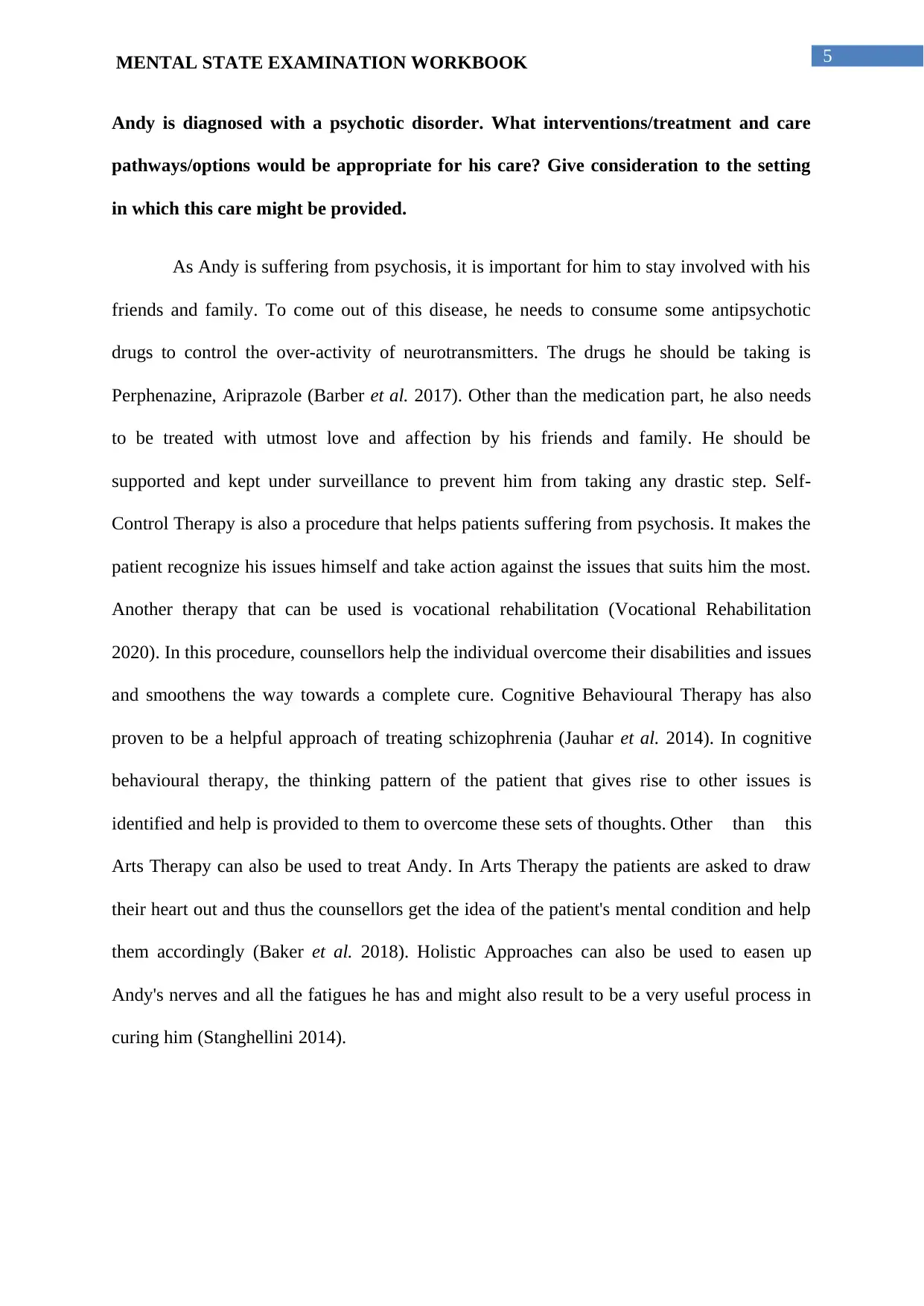
5MENTAL STATE EXAMINATION WORKBOOK
Andy is diagnosed with a psychotic disorder. What interventions/treatment and care
pathways/options would be appropriate for his care? Give consideration to the setting
in which this care might be provided.
As Andy is suffering from psychosis, it is important for him to stay involved with his
friends and family. To come out of this disease, he needs to consume some antipsychotic
drugs to control the over-activity of neurotransmitters. The drugs he should be taking is
Perphenazine, Ariprazole (Barber et al. 2017). Other than the medication part, he also needs
to be treated with utmost love and affection by his friends and family. He should be
supported and kept under surveillance to prevent him from taking any drastic step. Self-
Control Therapy is also a procedure that helps patients suffering from psychosis. It makes the
patient recognize his issues himself and take action against the issues that suits him the most.
Another therapy that can be used is vocational rehabilitation (Vocational Rehabilitation
2020). In this procedure, counsellors help the individual overcome their disabilities and issues
and smoothens the way towards a complete cure. Cognitive Behavioural Therapy has also
proven to be a helpful approach of treating schizophrenia (Jauhar et al. 2014). In cognitive
behavioural therapy, the thinking pattern of the patient that gives rise to other issues is
identified and help is provided to them to overcome these sets of thoughts. Other than this
Arts Therapy can also be used to treat Andy. In Arts Therapy the patients are asked to draw
their heart out and thus the counsellors get the idea of the patient's mental condition and help
them accordingly (Baker et al. 2018). Holistic Approaches can also be used to easen up
Andy's nerves and all the fatigues he has and might also result to be a very useful process in
curing him (Stanghellini 2014).
Andy is diagnosed with a psychotic disorder. What interventions/treatment and care
pathways/options would be appropriate for his care? Give consideration to the setting
in which this care might be provided.
As Andy is suffering from psychosis, it is important for him to stay involved with his
friends and family. To come out of this disease, he needs to consume some antipsychotic
drugs to control the over-activity of neurotransmitters. The drugs he should be taking is
Perphenazine, Ariprazole (Barber et al. 2017). Other than the medication part, he also needs
to be treated with utmost love and affection by his friends and family. He should be
supported and kept under surveillance to prevent him from taking any drastic step. Self-
Control Therapy is also a procedure that helps patients suffering from psychosis. It makes the
patient recognize his issues himself and take action against the issues that suits him the most.
Another therapy that can be used is vocational rehabilitation (Vocational Rehabilitation
2020). In this procedure, counsellors help the individual overcome their disabilities and issues
and smoothens the way towards a complete cure. Cognitive Behavioural Therapy has also
proven to be a helpful approach of treating schizophrenia (Jauhar et al. 2014). In cognitive
behavioural therapy, the thinking pattern of the patient that gives rise to other issues is
identified and help is provided to them to overcome these sets of thoughts. Other than this
Arts Therapy can also be used to treat Andy. In Arts Therapy the patients are asked to draw
their heart out and thus the counsellors get the idea of the patient's mental condition and help
them accordingly (Baker et al. 2018). Holistic Approaches can also be used to easen up
Andy's nerves and all the fatigues he has and might also result to be a very useful process in
curing him (Stanghellini 2014).
⊘ This is a preview!⊘
Do you want full access?
Subscribe today to unlock all pages.

Trusted by 1+ million students worldwide
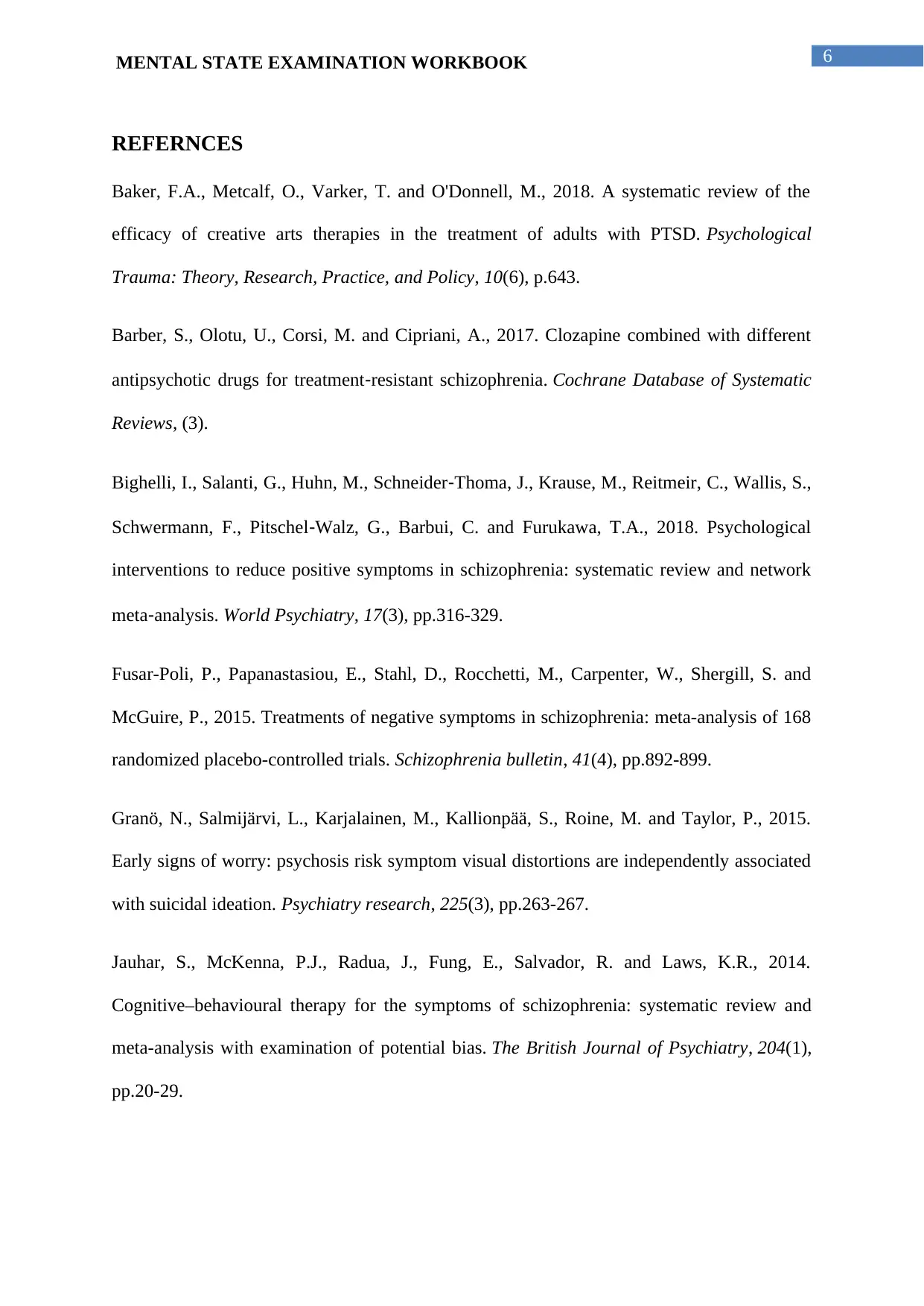
6MENTAL STATE EXAMINATION WORKBOOK
REFERNCES
Baker, F.A., Metcalf, O., Varker, T. and O'Donnell, M., 2018. A systematic review of the
efficacy of creative arts therapies in the treatment of adults with PTSD. Psychological
Trauma: Theory, Research, Practice, and Policy, 10(6), p.643.
Barber, S., Olotu, U., Corsi, M. and Cipriani, A., 2017. Clozapine combined with different
antipsychotic drugs for treatment‐resistant schizophrenia. Cochrane Database of Systematic
Reviews, (3).
Bighelli, I., Salanti, G., Huhn, M., Schneider‐Thoma, J., Krause, M., Reitmeir, C., Wallis, S.,
Schwermann, F., Pitschel‐Walz, G., Barbui, C. and Furukawa, T.A., 2018. Psychological
interventions to reduce positive symptoms in schizophrenia: systematic review and network
meta‐analysis. World Psychiatry, 17(3), pp.316-329.
Fusar-Poli, P., Papanastasiou, E., Stahl, D., Rocchetti, M., Carpenter, W., Shergill, S. and
McGuire, P., 2015. Treatments of negative symptoms in schizophrenia: meta-analysis of 168
randomized placebo-controlled trials. Schizophrenia bulletin, 41(4), pp.892-899.
Granö, N., Salmijärvi, L., Karjalainen, M., Kallionpää, S., Roine, M. and Taylor, P., 2015.
Early signs of worry: psychosis risk symptom visual distortions are independently associated
with suicidal ideation. Psychiatry research, 225(3), pp.263-267.
Jauhar, S., McKenna, P.J., Radua, J., Fung, E., Salvador, R. and Laws, K.R., 2014.
Cognitive–behavioural therapy for the symptoms of schizophrenia: systematic review and
meta-analysis with examination of potential bias. The British Journal of Psychiatry, 204(1),
pp.20-29.
REFERNCES
Baker, F.A., Metcalf, O., Varker, T. and O'Donnell, M., 2018. A systematic review of the
efficacy of creative arts therapies in the treatment of adults with PTSD. Psychological
Trauma: Theory, Research, Practice, and Policy, 10(6), p.643.
Barber, S., Olotu, U., Corsi, M. and Cipriani, A., 2017. Clozapine combined with different
antipsychotic drugs for treatment‐resistant schizophrenia. Cochrane Database of Systematic
Reviews, (3).
Bighelli, I., Salanti, G., Huhn, M., Schneider‐Thoma, J., Krause, M., Reitmeir, C., Wallis, S.,
Schwermann, F., Pitschel‐Walz, G., Barbui, C. and Furukawa, T.A., 2018. Psychological
interventions to reduce positive symptoms in schizophrenia: systematic review and network
meta‐analysis. World Psychiatry, 17(3), pp.316-329.
Fusar-Poli, P., Papanastasiou, E., Stahl, D., Rocchetti, M., Carpenter, W., Shergill, S. and
McGuire, P., 2015. Treatments of negative symptoms in schizophrenia: meta-analysis of 168
randomized placebo-controlled trials. Schizophrenia bulletin, 41(4), pp.892-899.
Granö, N., Salmijärvi, L., Karjalainen, M., Kallionpää, S., Roine, M. and Taylor, P., 2015.
Early signs of worry: psychosis risk symptom visual distortions are independently associated
with suicidal ideation. Psychiatry research, 225(3), pp.263-267.
Jauhar, S., McKenna, P.J., Radua, J., Fung, E., Salvador, R. and Laws, K.R., 2014.
Cognitive–behavioural therapy for the symptoms of schizophrenia: systematic review and
meta-analysis with examination of potential bias. The British Journal of Psychiatry, 204(1),
pp.20-29.
Paraphrase This Document
Need a fresh take? Get an instant paraphrase of this document with our AI Paraphraser
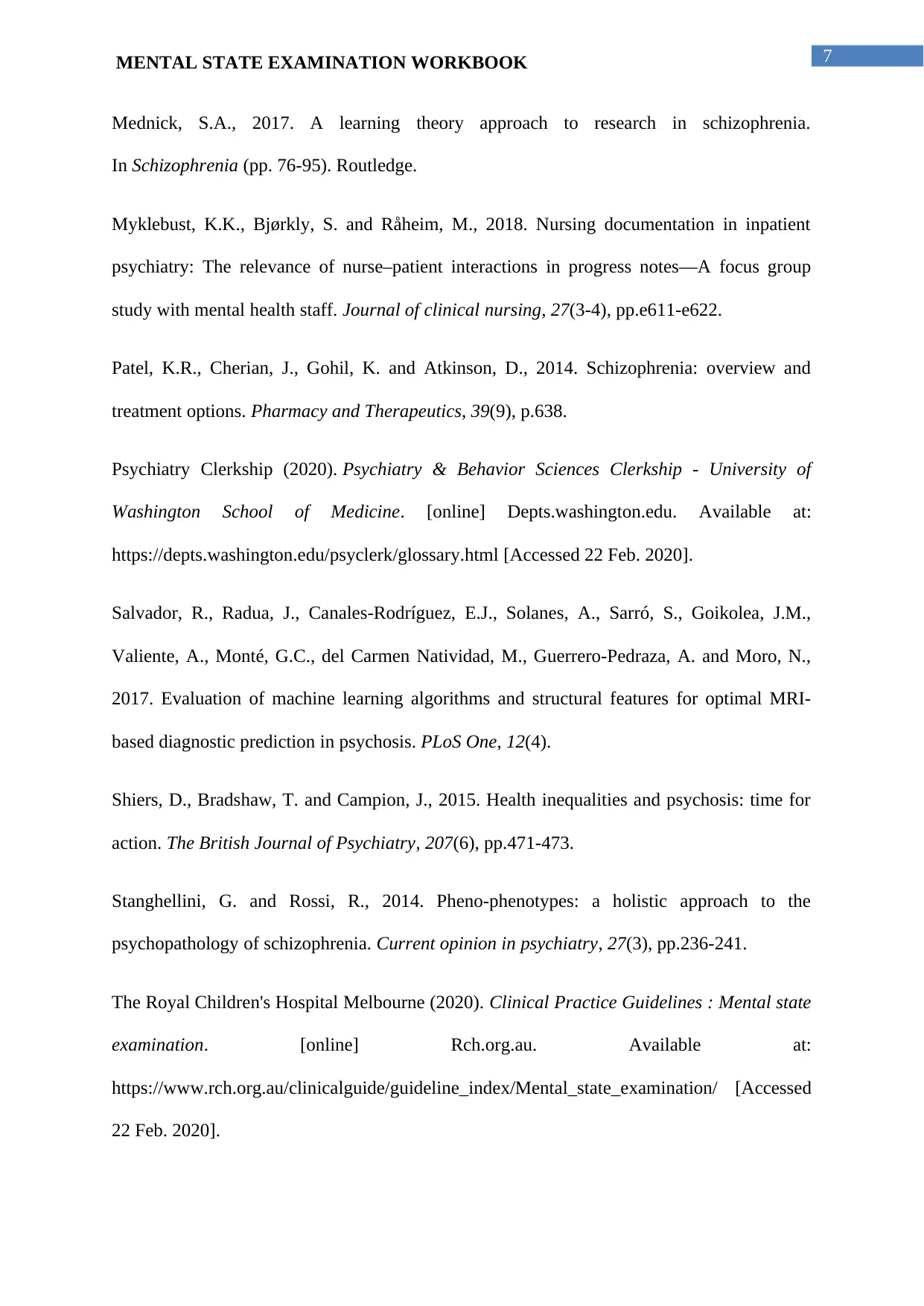
7MENTAL STATE EXAMINATION WORKBOOK
Mednick, S.A., 2017. A learning theory approach to research in schizophrenia.
In Schizophrenia (pp. 76-95). Routledge.
Myklebust, K.K., Bjørkly, S. and Råheim, M., 2018. Nursing documentation in inpatient
psychiatry: The relevance of nurse–patient interactions in progress notes—A focus group
study with mental health staff. Journal of clinical nursing, 27(3-4), pp.e611-e622.
Patel, K.R., Cherian, J., Gohil, K. and Atkinson, D., 2014. Schizophrenia: overview and
treatment options. Pharmacy and Therapeutics, 39(9), p.638.
Psychiatry Clerkship (2020). Psychiatry & Behavior Sciences Clerkship - University of
Washington School of Medicine. [online] Depts.washington.edu. Available at:
https://depts.washington.edu/psyclerk/glossary.html [Accessed 22 Feb. 2020].
Salvador, R., Radua, J., Canales-Rodríguez, E.J., Solanes, A., Sarró, S., Goikolea, J.M.,
Valiente, A., Monté, G.C., del Carmen Natividad, M., Guerrero-Pedraza, A. and Moro, N.,
2017. Evaluation of machine learning algorithms and structural features for optimal MRI-
based diagnostic prediction in psychosis. PLoS One, 12(4).
Shiers, D., Bradshaw, T. and Campion, J., 2015. Health inequalities and psychosis: time for
action. The British Journal of Psychiatry, 207(6), pp.471-473.
Stanghellini, G. and Rossi, R., 2014. Pheno-phenotypes: a holistic approach to the
psychopathology of schizophrenia. Current opinion in psychiatry, 27(3), pp.236-241.
The Royal Children's Hospital Melbourne (2020). Clinical Practice Guidelines : Mental state
examination. [online] Rch.org.au. Available at:
https://www.rch.org.au/clinicalguide/guideline_index/Mental_state_examination/ [Accessed
22 Feb. 2020].
Mednick, S.A., 2017. A learning theory approach to research in schizophrenia.
In Schizophrenia (pp. 76-95). Routledge.
Myklebust, K.K., Bjørkly, S. and Råheim, M., 2018. Nursing documentation in inpatient
psychiatry: The relevance of nurse–patient interactions in progress notes—A focus group
study with mental health staff. Journal of clinical nursing, 27(3-4), pp.e611-e622.
Patel, K.R., Cherian, J., Gohil, K. and Atkinson, D., 2014. Schizophrenia: overview and
treatment options. Pharmacy and Therapeutics, 39(9), p.638.
Psychiatry Clerkship (2020). Psychiatry & Behavior Sciences Clerkship - University of
Washington School of Medicine. [online] Depts.washington.edu. Available at:
https://depts.washington.edu/psyclerk/glossary.html [Accessed 22 Feb. 2020].
Salvador, R., Radua, J., Canales-Rodríguez, E.J., Solanes, A., Sarró, S., Goikolea, J.M.,
Valiente, A., Monté, G.C., del Carmen Natividad, M., Guerrero-Pedraza, A. and Moro, N.,
2017. Evaluation of machine learning algorithms and structural features for optimal MRI-
based diagnostic prediction in psychosis. PLoS One, 12(4).
Shiers, D., Bradshaw, T. and Campion, J., 2015. Health inequalities and psychosis: time for
action. The British Journal of Psychiatry, 207(6), pp.471-473.
Stanghellini, G. and Rossi, R., 2014. Pheno-phenotypes: a holistic approach to the
psychopathology of schizophrenia. Current opinion in psychiatry, 27(3), pp.236-241.
The Royal Children's Hospital Melbourne (2020). Clinical Practice Guidelines : Mental state
examination. [online] Rch.org.au. Available at:
https://www.rch.org.au/clinicalguide/guideline_index/Mental_state_examination/ [Accessed
22 Feb. 2020].
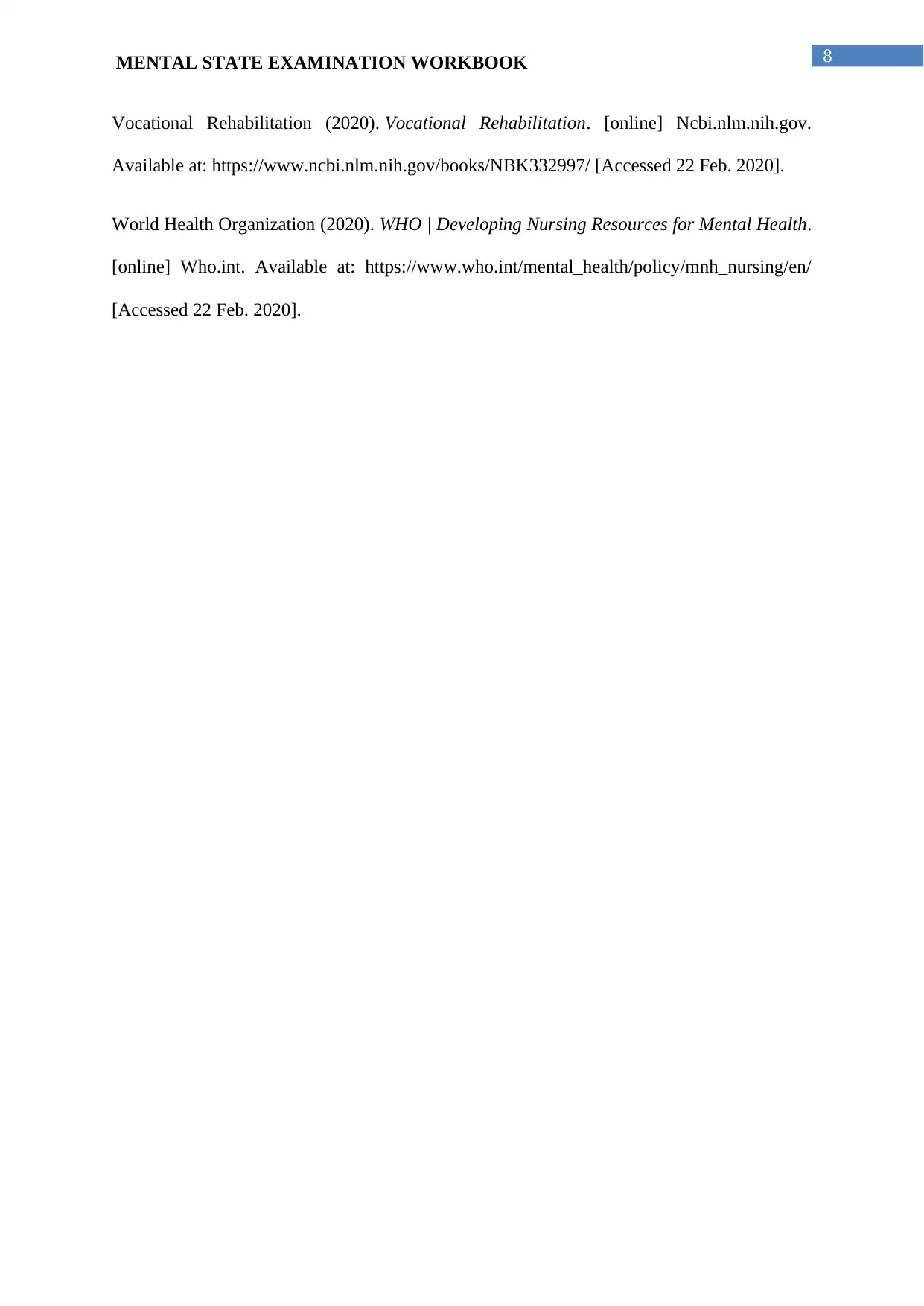
8MENTAL STATE EXAMINATION WORKBOOK
Vocational Rehabilitation (2020). Vocational Rehabilitation. [online] Ncbi.nlm.nih.gov.
Available at: https://www.ncbi.nlm.nih.gov/books/NBK332997/ [Accessed 22 Feb. 2020].
World Health Organization (2020). WHO | Developing Nursing Resources for Mental Health.
[online] Who.int. Available at: https://www.who.int/mental_health/policy/mnh_nursing/en/
[Accessed 22 Feb. 2020].
Vocational Rehabilitation (2020). Vocational Rehabilitation. [online] Ncbi.nlm.nih.gov.
Available at: https://www.ncbi.nlm.nih.gov/books/NBK332997/ [Accessed 22 Feb. 2020].
World Health Organization (2020). WHO | Developing Nursing Resources for Mental Health.
[online] Who.int. Available at: https://www.who.int/mental_health/policy/mnh_nursing/en/
[Accessed 22 Feb. 2020].
⊘ This is a preview!⊘
Do you want full access?
Subscribe today to unlock all pages.

Trusted by 1+ million students worldwide
1 out of 9
Related Documents
Your All-in-One AI-Powered Toolkit for Academic Success.
+13062052269
info@desklib.com
Available 24*7 on WhatsApp / Email
![[object Object]](/_next/static/media/star-bottom.7253800d.svg)
Unlock your academic potential
Copyright © 2020–2026 A2Z Services. All Rights Reserved. Developed and managed by ZUCOL.





